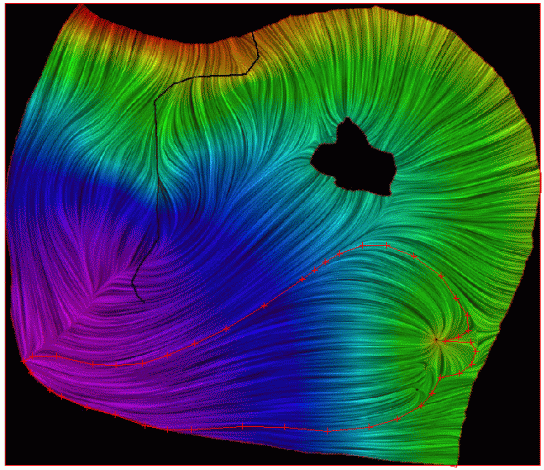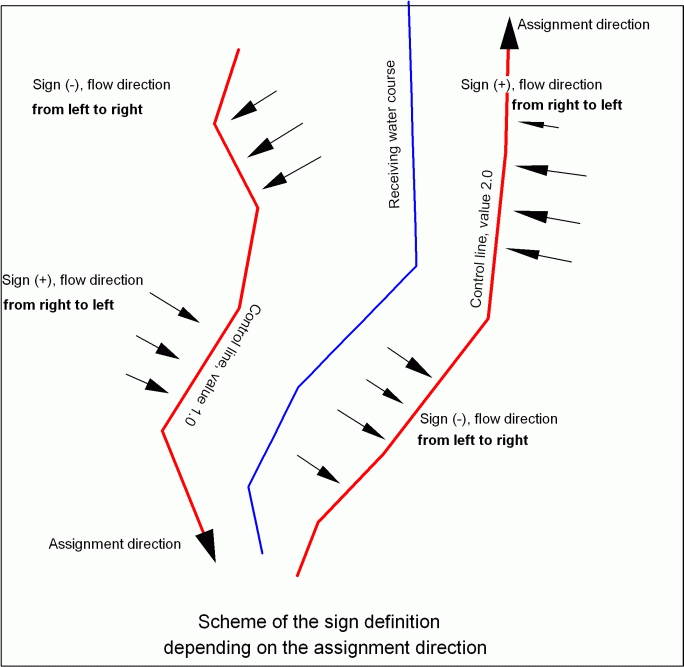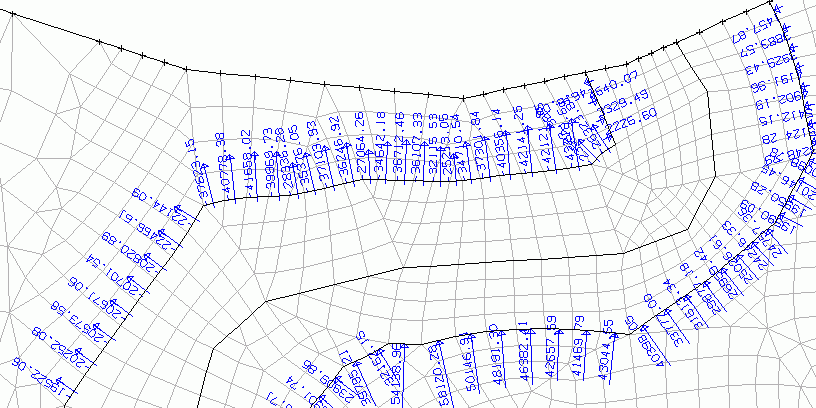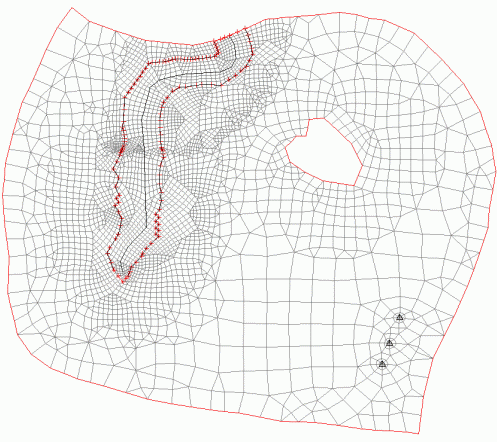If a receiving water course exists in the investigation area which is defined by the attributes VORF and LERA (or LEKN) you can balance the in- and outflow to the water course with the help of control lines. In the known example file the local area around the receiving water course is refined one respectively two times. Then two control lines are created more or less parallel to the receiving water course. In this control volume, which is limited on the western and eastern side by the control lines, in the north by the main receiving water course and in the south by an imaginary line between the ends of the control lines, the in- and outflow rates are balanced. The mass balance in the steady state must have identical in-and outflows.
The following parameters are necessary:

Inflow (+) and outflow (-) over the control lines in the control volume (KONT)

Groundwater recharge in the control volume (FLAE)

Leakage quantity of the water course (leakage coefficients LERA, LEKN)

Outflow through the fixed potential heads at the embouchure (Mass flow rates)
Creating the control lines
The amount of water which is calculated by the control line computation corresponds to the groundwater runoff of the receiving water course. Looking at the Schlieren shows clearly that the water course has only a minor connection to the groundwater because the Schlieren run mainly parallel and not to the water course.

Schlieren image of the model
The control lines are created in SPRING with Attributes  Assign
Assign  Direct
Direct  KONT. After running the flow computation the quantities flowing over each element side and of the whole control line can be read in the output file (out.* after GEONEU or SITRA).
KONT. After running the flow computation the quantities flowing over each element side and of the whole control line can be read in the output file (out.* after GEONEU or SITRA).
The signs of the given quantities depend on the assignment direction of the nodes: Looking IN assignment direction, the flow from right to left has a positive sign! Otherwise the sign must be negative.

Scheme of the flow direction depending on the assignment direction

Control lines and quantities (clipping)
An inflow (+) arises from the eastern side in the control volume and an outflow (-) results at the western side of the control volume.
Although the total sums of both control lines are positive, the value of the western line must be put negative because it is an outflow of the control volume. After the flow computation (SITRA, partial saturation, 5 iterations) the following amounts result: western line: (-) 740284 m³/a, eastern line: (+) 808193 m³/a.
Calculation of the groundwater recharge
After creating the control lines an area structure is created which covers the entire control volume (Structure  New
New  Flat). With View
Flat). With View  Calculate area (or the corresponding button
Calculate area (or the corresponding button  ) and selecting the control volume the area of it is shown in the status bar of the main window. It amounts to 1975284 m². Multiplicated with the groundwater recharge rate of 0.200 m³/m²/a a groundwater recharge of 395057 m³/a results.
) and selecting the control volume the area of it is shown in the status bar of the main window. It amounts to 1975284 m². Multiplicated with the groundwater recharge rate of 0.200 m³/m²/a a groundwater recharge of 395057 m³/a results.

Flat structure for the groundwater recharge calculation
Determining the leakage rates
For calculating the leakage rate the attribute BILK has to be assigned to the nodes of the water course. Then the total leakage quantity is given in the output file: it amounts to - 209405 m³/a.
Determining the mass flow rates
The water course flows into a main receiving stream, so the outflow through the fixed potential heads has to be considered as well. The quantities are read in SPRING with Attributes  Import model data/computation results...
Import model data/computation results...  aaa
aaa  mass flow rates
mass flow rates  KKKK. With Attributes
KKKK. With Attributes  Computation
Computation  Sum attributes...
Sum attributes...  in polygon you can sum up the mass flow rates inside the control volume. The mass flow rates of the left and right "boundary nodes" of the control volume are averaged and added up only one time. So the total mass flow quantity in the control volume amounts to - 260292 m³/a.
in polygon you can sum up the mass flow rates inside the control volume. The mass flow rates of the left and right "boundary nodes" of the control volume are averaged and added up only one time. So the total mass flow quantity in the control volume amounts to - 260292 m³/a.
If all required values are determined you can balance them [m³/a]:
|
395057 |
+ 808193 |
- 740284 |
- 209405 |
- 260292 |
= |
-6731 [m³/year] |
|
Groundwater recharge |
Inflow |
Outflow |
Leakage |
Mass flow |
=! |
0 |
The deviation of - 6731 [m³/a] corresponds to 0.6% of the negative water quantity.
The mass balance is a useful tool to check the position of the control lines. The exactness of a control line depends considerably on the discretization and on the flow direction: the more upright the flow the more accurate the from the velocity derived quantity (Q = V * K * I).
 Quantity of water flowing through a lake (GLEI)
Quantity of water flowing through a lake (GLEI)
